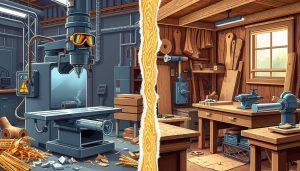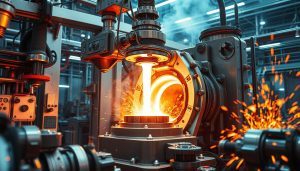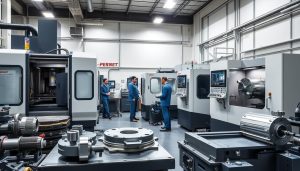Surface roughness is a critical factor in manufacturing, engineering, and product design. This comprehensive guide will explore the fundamentals of surface roughness, its importance, measurement techniques, and interpretation of surface finish parameters. Whether you’re an engineer, manufacturer, or quality control professional, understanding surface roughness can help you optimize product performance, enhance aesthetics, and ensure compliance with industry standards.
What is Surface Roughness?
Surface roughness is a crucial factor in the design and manufacturing of products across various industries. It refers to the surface texture and surface profile of a material, which directly impacts its functionality, performance, and aesthetic appeal. Understanding the roughness parameters is essential for optimizing product quality and meeting specific requirements.
Definition and Importance of Surface Roughness
Surface roughness is a measure of the small-scale variations in the height of a surface. It’s an essential characteristic that can influence a product’s durability, friction, wear resistance, and even optical properties. Manufacturers strive to achieve the desired surface roughness to ensure optimal product performance and meet industry standards.
Key Parameters: Ra, Rz, and Rq
- Ra (Average Roughness) is the most commonly used parameter, representing the average deviation of the surface profile from the mean line.
- Rz (Maximum Height of the Profile) measures the distance between the highest peak and lowest valley on the surface.
- Rq (Root Mean Square Roughness) is the square root of the mean of the squared individual roughness values, providing a more sensitive measure of the surface profile.
These key parameters are essential for quantifying and analyzing the surface roughness of materials, enabling manufacturers to make informed decisions and achieve the desired product performance.
How to Measure Surface Roughness
Accurately measuring surface roughness is crucial for various industries, from manufacturing to quality control. Surface roughness measurement techniques can be broadly categorized into two main approaches: contact methods and non-contact methods. Understanding the different measurement techniques and the tools available is essential for obtaining reliable and accurate surface roughness data.
Common Measurement Techniques: Profilometer, Contact, and Non-Contact Methods
One of the most widely used instruments for measuring surface roughness is the profilometer. Profilometers utilize a stylus that physically moves across the surface, recording the vertical variations to provide a detailed profile of the surface topography. This contact-based method offers high-precision measurements but can potentially damage delicate surfaces.
In contrast, non-contact optical measurement techniques, such as laser profilometry and interferometry, use light-based scanning to capture the surface roughness without physically touching the sample. These methods are particularly useful for measuring fragile or soft surfaces, as well as for in-situ monitoring and quality control applications.
Tools and Instruments for Surface Roughness Measurement
- Stylus Profilometers: These contact-based instruments use a diamond-tipped stylus to physically trace the surface, providing detailed roughness data.
- Optical Profilometers: Utilizing non-contact optical techniques, these instruments use light interference or confocal scanning to measure surface topography.
- Atomic Force Microscopes (AFM): Offering nanometer-scale resolution, AFMs use a sharp probe to scan the surface, providing ultra-high-precision roughness data.
- Portable Surface Roughness Testers: Handheld, portable devices that allow for quick and convenient on-site surface roughness measurements.
Best Practices for Accurate Surface Roughness Measurement
To ensure reliable and consistent surface roughness measurements, it’s essential to follow best practices. This includes proper sample preparation, calibration of the measurement instrument, and adherence to industry standards and guidelines. Additionally, considering factors such as environmental conditions, measurement area, and data analysis can significantly improve the accuracy and repeatability of surface roughness assessments.

By understanding the various measurement techniques and employing the right tools and best practices, manufacturers and quality control professionals can effectively evaluate and optimize the surface roughness of their products, leading to improved functionality, aesthetics, and overall performance.
Surface Roughness Values and Their Meaning
Understanding surface roughness values is crucial in manufacturing and engineering. Two key parameters to consider are Ra (average roughness) and Rz and Rq (surface parameters). Let’s dive into the interpretation of these important surface roughness values.
Interpreting Ra (Average Roughness) Values
Ra, or average roughness, is the most commonly used surface roughness parameter. It measures the average deviation of the surface profile from the mean line. A lower Ra value indicates a smoother surface, while a higher Ra value suggests a rougher surface. Typical Ra values range from less than 0.1 micrometers for highly polished surfaces to over 10 micrometers for coarse, unfinished surfaces.
Understanding Rz and Rq Surface Parameters
In addition to Ra, other surface roughness parameters like Rz (maximum height of the profile) and Rq (root mean square roughness) can provide valuable insights. Rz measures the average distance between the highest peak and lowest valley, while Rq is the square root of the average of the squared profile deviations. These parameters can help differentiate between surfaces with similar Ra values but varying peak-to-valley heights or overall profile characteristics.
Comparing Different Surface Roughness Levels
Comparing surface roughness levels across materials and manufacturing processes is essential for quality control and product performance. For instance, a smooth, polished surface may be desirable for aesthetic applications, while a rougher texture may be preferred for improved grip or adhesion. By understanding the surface roughness values, engineers can make informed decisions to optimize the surface finish for their specific requirements.

“Surface roughness is a critical factor in determining the performance and lifespan of many products. Accurately measuring and interpreting these values is essential for ensuring quality and meeting customer expectations.”
Surface Roughness and Its Impact on Manufacturing
Surface roughness is a critical factor in manufacturing that can significantly impact the functionality, performance, aesthetics, and durability of a product. This aspect of manufacturing quality has far-reaching implications across various industries, from automotive and aerospace to medical devices and consumer electronics.
Effects on Functionality and Performance
The surface finish of a product can directly influence its functionality and overall performance. For instance, in the automotive industry, the surface roughness of engine components, such as pistons and crankshafts, can impact factors like surface finish impact, friction, and wear. Achieving the optimal surface roughness is crucial for ensuring efficient power transmission and minimizing energy losses.
How Surface Finish Affects Aesthetics and Durability
Beyond functional considerations, surface finish also plays a vital role in the visual appeal and long-term product performance of a manufactured item. In consumer products, a smooth, polished surface can enhance the perceived manufacturing quality and overall aesthetic appeal, which is critical for driving sales and customer satisfaction. Additionally, the surface finish can impact the product’s durability, as a smoother surface is often more resistant to wear, corrosion, and other environmental factors that can degrade the appearance and lifespan of the product.
Manufacturers must carefully consider the optimal surface roughness for their products, balancing the need for functional performance, aesthetic appeal, and long-term durability. By understanding the impact of surface finish impact on their manufacturing processes, companies can enhance their product performance and deliver high-quality, reliable products to their customers.
“Achieving the right surface roughness is critical for ensuring the optimal performance and longevity of our products. It’s a delicate balance that our engineering team works tirelessly to perfect.”
– Jane Doe, Director of Manufacturing, XYZ Corp.
Common Methods to Achieve Desired Surface Roughness
Achieving the perfect surface finish is crucial in manufacturing, as it directly impacts the functionality, aesthetics, and durability of a product. From traditional techniques to emerging technologies, there are various methods to control and enhance surface roughness. Let’s explore some of the common approaches to attain the desired surface finish.
Techniques for Fine Finishing: Polishing and Grinding
Polishing and grinding are widely used surface finishing techniques to achieve a smooth, mirror-like appearance. Polishing involves the use of abrasive materials and specialized equipment to remove tiny irregularities and imperfections from the surface. This process can dramatically reduce the surface roughness, resulting in a high-gloss finish. Grinding, on the other hand, utilizes abrasive wheels or belts to precisely remove material from the surface, creating a consistent and uniform finish.
Coatings and Treatments to Enhance Surface Finish
In addition to mechanical finishing methods, various coatings and treatments can be applied to enhance the surface finish. Surface coatings, such as paints, lacquers, or electroplating, can provide a smooth, uniform, and protective layer on the underlying material. These coatings can also improve the aesthetic appeal and durability of the surface. Surface treatments, like anodizing or chemical etching, can also modify the surface properties and reduce surface roughness.
3D Printing and Surface Roughness Control
The emergence of 3D printing technology has revolutionized the way we approach surface roughness control. By carefully selecting 3D printing techniques, materials, and post-processing methods, manufacturers can now achieve remarkably smooth surfaces on 3D-printed parts. From advanced powder-based 3D printing to innovative finishing techniques like vapor smoothing, the capabilities of 3D printing continue to evolve, offering new opportunities to precisely control surface roughness.
“The quality of the surface finish is just as important as the overall design and functionality of a product. It’s the attention to detail that sets great products apart.”
Whether you’re working with traditional manufacturing processes or exploring the latest advancements in 3D printing, understanding and implementing the right surface finishing techniques is crucial to achieving the desired level of surface roughness and delivering high-quality products.
Surface Roughness Comparison Chart
This section presents a comprehensive surface roughness comparison chart, highlighting the common surface finishes and their corresponding roughness values. Additionally, it provides a comparison of different manufacturing processes and their impact on surface roughness, empowering readers to make informed decisions when selecting production methods.
Common Surface Finishes and Their Corresponding Roughness Values
The surface roughness comparison chart outlines a range of common surface finishes, from the ultra-smooth mirror finish to the coarser ground surface. Each finish is accompanied by its corresponding roughness values, measured in terms of Ra (average roughness) and Rz (maximum height of the profile). This information helps manufacturers and engineers understand the appropriate surface finish for their specific application requirements.
Comparison of Different Manufacturing Processes
The chart also compares the surface roughness capabilities of various manufacturing processes, including milling, turning, grinding, and polishing. This comparison highlights the strengths and limitations of each process, enabling users to select the most suitable production method based on their desired surface finish and quality targets. By understanding the surface roughness characteristics of different manufacturing techniques, professionals can optimize their production workflows and achieve the desired product performance and aesthetics.





